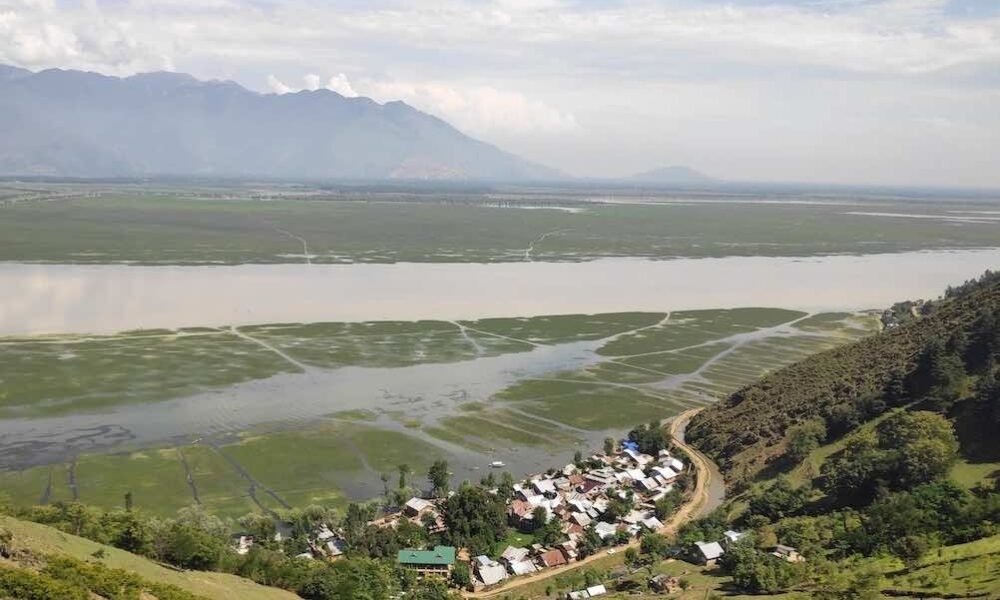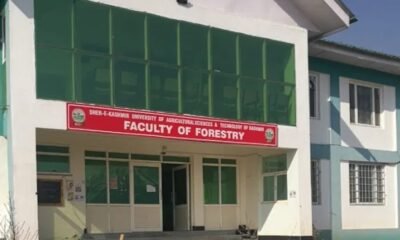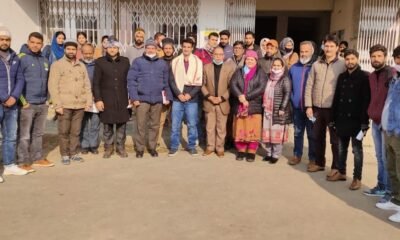Ecology
Wular: Asia’s largest freshwater lake fights for existence
Published
2 years agoon
By
BK Editor
Once known as Asia’s largest freshwater lake, Wular has shrunk almost 50% of its original area over the last few decades due to administrative negligence, encroachment, siltation and contamination.
Situated in northern Kashmir’s Bandipora and Baramulla districts, Wular Lake is struggling to survive as it battles the discharge of sewage and trash from the nearby towns, particularly from Bandipora and Sopore towns.
Wular Lake, notified as a Ramsar Wetland in 1990, might have been a fantastic tourist destination that everyone was anticipating if not for the nearby municipalities directly disposing of solid garbage into the water body on the daily basis.
For many families in Bandipora and Sopore, Wular used to be their main supply of fresh water and a means of subsistence. Additionally, it was famed for producing great fish and water chestnuts, but that is not currently apparent.


“The water in the lake was crystal pure a few years ago, but it is now extremely contaminated and unfit even for washing clothes and feeding animals,” he continued.
Ishfaq Ahmad, a resident from Sopore, told this reporter that migratory birds that frequently used to visit the lake in the past had not been seen in the last couple of years, possibly as a result of the lake’s increasing pollution.
Wular Lake’s chestnuts trade
Boatmen living on the banks and peripheries of the Wular Lake used to go out in the early morning hours, row their boats into the lake, and come back in the evening with boats full of chestnuts. About 90% of the population, according to the locals, was dependent on harvesting chestnuts from Wular for their livelihood. The local merchants that rely on Wular claim that over the past five years, problems have arisen due to an increase in pollution that has led to the extinction of numerous aquatic species. “Fishes are in an endangered zone in Wular, and it is difficult to detect the water bodies in the lake due to a lack of signage,” a Sopore resident Abdul Rashid Dar said.
Wular Lake’s dredging operation by WCMA
The lake spans over 24 kilometres in length and 10 km in breadth, encompassing an area of 200 square km in total. However, since 1911, the area of the surface and the marshlands around it have decreased, falling from 216 square kilometres (83 square miles) to 104 square kilometres (40 square miles).
The Wular Conservation and Management Authority (WCMA), which was established for the lake’s conservation, is now performing dredging operations in the Wular for its restoration, with work ongoing on 1.50 sq km of the lake.
Rs 200-crore Wular Action Plan for the conservation and management of Wular Lake, according to WCMA officials, has allowed for the large-scale dredging of Wular Lake.
Around 10 Kanal of land encroachment on the Wular Lake area have been cleared by the authorities. According to an official of the concerned department, there were about 90 kanal of land that was being encroached upon near Wular Lake, 10 Kanal of which have been cleared.


“Wular has occupied an enormous area, and when the valley experienced floods in 2014, the water that entered the city of Srinagar from the River Jehlum was then transferred to Wular and thus spared the Srinagar city from a fiasco,” he said.
A Public Interest Litigation
As part of a Public Interest Litigation, the Jammu and Kashmir High Court sent notices to the Government of India and J&K administration last year, requesting their assistance in clearing the trash that had been dumped along the northern Kashmiri shores of Wular Lake, the largest freshwater lake in Asia.
The court had passed the directions after hearing Advocate Shafqat Nazir for the petitioners, who sought a slew of measures from the Union Ministry of Environment, Forest and Climate Change and the J&K Government.
The petitioners also demanded that the Municipal Council of Sopore be ordered to stop disposing of municipal solid waste on the Ramsar wetland site at Dharnambal-Ningli Tarzoo in Sopore, which is located within the boundaries of the Hygam-Ningli-Tarzoo Tourism Development Authority and the Wular Conservation and Management Authority.
Given Wular Lake’s huge tourism potential and concern for environmental sensitivity, the petition had called for its planned development. It further requests that a location be designated and thereafter built in accordance with Solid Waste Management Rules for the disposal of municipal waste far from residential areas and environmentally sensitive areas.
The petitioners had alleged that the Municipal Council Sopore since March last year has started dumping solid waste on the boundary of the Wular Lake against the Solid Waste Management Rules.
Since the land in question belongs to the Forest Department and comes under the immediate control and management of WCMA and HNTDA, therefore it was obligatory for the respondent Municipal Council to take prior permission from the said authorities before dumping the municipal waste on the banks of Wular Lake.
The Ramsar notified site and potential tourist destination, Wular Lake has regrettably been turned into an open garbage dumping site even though the district administration had previously identified and designated about 50 kanal of land in estate Adipora for the dumping of garbage, as is made evident by the communication from the deputy commissioner in Baramulla to the Director of the Urban Local Bodies in Kashmir on July 30, 2019.
NGT seeks report on Wular Lake
In response to allegations that solid municipal trash was dumped in Wular Lake, the National Green Tribunal (NGT) ordered the authorities in Jammu and Kashmir to submit an action taken report.
The NGT had instructed the Jammu and Kashmir Pollution Control Board and the collector of the Baramulla district to write a factual report after hearing a plea that was submitted by RTI activist Raja Muzaffar Bhat.


The National Green Tribunal (NGT) had also directed the authorities in Jammu and Kashmir to file an action taken report on the alleged dumping of solid municipal waste in Wular Lake.
PCB’s Rs 64 lakh fine
Municipal Council Badipora was fined Rs 64 lakh by the J&K Pollution Control Board (PCB) in April for breaking the solid waste management rules. As part of an environmental compensation action, the fine has been levied.
The PCB previously notified MC Bandipora that it had received photographic evidence of “illegal and illogical” solid waste dumping and disposal by the municipal council in Bandipora. As a result, the matter was brought up with the concerned deputy commissioner, director of the urban local body, and executive officer of MC Bandipora through a series of communications, but nothing substantive changed on the ground.
It had expressed that because of persistent disappointment of the Executive Officer MC Bandipora to discard solid waste in a scientific way, a show-cause notice for imposing ecological pay considering the directions of the National Green Tribunal was served upon the Executive Officer Municipal Council Bandipora calling upon him to show reasons in 15 days concerning why the environmental compensation be not levied upon him for these explicit infringements of Environmental Laws.
“Regional Director PCB has also received photographic evidence indicating that no improvement on the ground was brought about by the concerned municipal body and the solid waste is continuously dumped at Zalwan Nassu site near the district headquarter Bandipora and on the catchment of Wular Lake near Zalwan Nallah in a haphazard and unscientific manner,” it reads.
It had said that the Executive Officer Municipal Committee, Bandipora is directed to deposit a sum of Rs 64.21 lakh, as environmental compensation in the Environmental Compensation Fund within 45 days and on the lapse of this period interest at the rate of 12% on the compensation amount shall be at the risk and responsibility of the Executive Officer.
Introducing Shikaras in Wular
Introducing shikara (wooden boats) rides to boost tourism in the Wular Lake, one of the largest freshwater lakes in Asia. The lake is located in the northern sections of Kashmir and spans a total area of 130 square kilometres. It is situated at the foothills of Harmukh Mountain.


“We will start it on a trial basis,” he said, adding that the main aim is to attract more tourists to the lake, which will help the local people to earn a living from it.
The WCMA has also made a proposal for a walkway which will be about 3.20 km around the lake area which has been restored and work on it will start soon, he said, adding that the cost of the project is Rs 90 crore.
According to the WCMA official, only locals will be considered for these Wular initiatives that would improve their standard of living. “I am confident that the Lake will undergo significant development and grow into a popular tourist destination over the course of the next six months,” said the official.
-


Wular Lake the largest freshwater lake in the world has reduced to half of its original size in last few decades.
-


-


-


-




You may like
-




Kya kuchh tha jiske kehne ko: A tribute to father
-




GNK hosts JAI scholarship distribution function
-




Administrative Council approves J&K Startup Policy 2024-27
-




How to begin investing
-




The rising modest fashion sector of Kashmir
-




J&K Oil Tankers Union demands package, seeks tax rebate for transport sector in Budget 2024
Ecology
Economic and Environmental Implications of Sand Mining in Kashmir Division
Published
6 months agoon
January 15, 2024By
BK Editor

Uzma Hameed
Dhaar Mehak M.
Sand mining is the process of extracting sand from in and around the rivers, streams, lakes etc. Sand is also mined from beaches and inland dunes and dredges from ocean beds and river beds. In modern times sand is considered to be an essential raw material for construction purposes. As such, individual and private companies are increasingly demanding sand for construction purposes and this has placed immense pressure on sand resources. As a practice it is becoming an environmental issue as the demand for sand has been persistently witnessing an increase in industry and construction sectors of the economy especially in the developing pockets of the world. In developing nations, including India the annual demand for sand has been witnessing a perpetual rise of 07%. This has led to both an increase in the demand and price of sand in the open market. At the same time, people have been witnessing a profitable venture out of mining sand both legally and illegally leading to a number of issues and concerns.
Mining has been identified as the spine of the construction and infrastructure-centric economic growth and development process of the developing world, India being no exception to the same. Given the geographic extent of the country, the sand resources in the country have been plenty. However, like any other natural resource, the quantum of sand in India is limited. The usage however has been in practice right from the pre-historic times, the demand and usage being all time high in the contemporary times. The first recorded history of mining in India dates back to 1774 when the English company was granted permission by the East India Company for mining coal in the Raniganj coal fields.
After the colonial independence of the country, the growth of mining under the aegis of successive five-year planning processes has been quite speedy. Mining is among the significant economic activities of the country. The Gross Domestic Product (GDP) contribution of mining in India ranges between 2.2% and 2.5%. Given the historicity associated with mining in the country, its extraction and utilization processes have undergone a major shift towards modernization. The economic reforms of the 1991 and 1993 National Mining Policy further especially contributed towards the growth of the mining sector. The Indian mining industry in contemporary times provides job opportunities to around 7 lakh individuals. Given the diversity of the mining activities across the country, each state specializes in a related activity that it possesses a comparative advantage in especially in light of the reserves.
Given the geographic nature and extent of the region of Jammu and Kashmir, sand deposits in the region have been a common sight. At the same time, given the cold climate of the region, the need for secure housing has always been prioritized by the populace and governance of Jammu and Kashmir. With the evolution of construction processes and techniques, the shift from traditional wooden houses towards modern concrete houses has been widely witnessed. One of the main raw materials used for the construction of such houses has been identified as sand.
There are approximately 261 mineral blocks across the districts of Kashmir amongst whom the majority are situated along the bank of the river Jhelum. The mineral blocks in Kashmir contain sand deposits and various other minerals. One of the mining hotspots of the Kashmir division is the town of Bijbehara, locally known as Vejibror. While Bijbihara is also known as the town of Chinars, it has historically been a significant contributor towards the local economy. The town is located on National Highway 44 along the extended banks of the Jhelum River. It is also known as “Town of Chinars”. It is situated about 45 km from the capital of the Union Territory of Jammu and Kashmir, Srinagar. Within the Bijbehara town, the area of Gadhanji-Pora is particularly the committed hotspot of mining activities. It is situated approximately half a kilometre away from the Sub-District headquarters of Bijbehara.
According to the stakeholders, the most prolific user of sand is the construction industry. Individuals are increasingly demanding sand for domestic and commercial construction purposes. While there has been an increase in both the demand and prices of the resource, it has placed immense pressure on the local sand resources and deposits. Locally sand is being used in almost every construction-related activity from cement and concrete to plastering, roofing, grouting, painting etc. It is also commonly used in constructions like mortar, concrete, and cement strength, mass and stability.
Because of its smooth texture, better bonding qualities, and low impurity concentration, river sand is the most often utilised in Kashmir due to its quality, quantity and availability. Sand is the key component of concertation. Sand mining is rampant at many places along the Jhelum River, especially in the Bijbehara.
Given the extensive mining in the region, at certain points, the miners have breached the banks of rivers. The miners often drive their heavy vehicles straight into the water causing huge damages to the bunds along the river. These miners have lately also been using other heavy machinery like machine excavators and bulldozers in attempts to extract more sand in less time. By removing more sand than the rivers can naturally replace with the sediments it carries downstream, sand mining activities carve a deeper and narrower bed. It further goes on to lower the water levels in the river below the usual, speeds up the flow and erodes the banks. The biodiversity within and along the river is damaged. The fishes and other aquatic species that closely rely on the local bio-diversity are increasingly coming under threat.
Abdul Rehman, a local resident and fisherman, who has been fishing for the past 40 years describes his deteriorating experience, “Earlier if I covered an area of 3 km in the river, I would catch 6-8 kilograms of fish. Now, covering the same distance, I barely manage to catch 250 grams”. People from the Pazalpora area of Bijbehara, where the banks have been breached at multiple places, lament that they have been left all the more vulnerable to reoccurring floods because of unthoughtful activities like these.
The sand miners in and around the Bijbehara area of Anantnag district have been vandalizing the Jhelum River illegally. The damage is being increased manifold by the increasing use of heavy machinery for speedy mining of sand. After the devastating floods of 2014, the state government has been spending a significant amount of state money on the restoration, repair and upgrading of the banks of the river Jhelum. The so called and rightly called, ‘sand mafia’ across the valley in general and Bijbehara area in particular is breaching the sensitive river banks for the monetary interest of a few greedy people.
As such, as a collective voice basing our understanding on the facts mentioned above, it falls upon both people and the authorities to look deeper into the issue. As a matter of sustainability, now is the high time that the matter is dealt with an iron fist.
The authors are affiliated with the Department of Economics, Islamic University of Science and Technology and can be reached at dhaarmehak@gmail.com
Ecology
Conserving Hangul: The Kashmir’s Pride
Published
2 years agoon
October 25, 2022By
BK Editor

Sabreen Nazir
The Kashmir Stag or Hangul, Cervus hanglu hanglu, was earlier considered a subspecies of the European red deer and now the subspecies of Tarim Red deer (Cervus hanglu) is presently distributed in Dachigam National Park and its adjoining Protected areas. Hangul was once distributed widely in the mountains of Kashmir. A small population existed outside Jammu & Kashmir in the Chamba district of Himachal Pradesh which is now extinct. At present, the only viable population of red deer in Kashmir is confined to 141 Km² Dachigam National Park (DNP), with a few isolated hangul herds in its adjoining protected areas. The hangul population is significantly inbred and exhibits a low genetic diversity in comparison to other deer populations of the world. Hangul spends most of its time in high mountain meadows in the alpine and sub-alpine zones or in the bottom of river Daghwan in Dachigam National Park. Hangul is reported to show a preference for mid-altitudes between 1700-2300 m and mostly for south-facing slopes. Autumn is the rutting season for the magnificent Kashmir Red deer. The mating season starts in September and extends up to November. The gestation period of 249-262 days (8 to 8½ months) results in single birth (twins are rare). This low annual production is offset by high investment in protective maternal care. Hangul gives birth in late May or early June. Females are sexually active between sixteen months to 02 years and males attain sexual maturity at the age of around 03 years, although young males do not usually mate due to competition from the more mature stags. The mean life expectancy is about 10 years. The highest period of mortality is in their first year, with over 80% of these deaths occurring within the first week of birth. Vulnerability during this period is dependent upon weather and predation. Due to its restricted range distribution, very low population size and great conservation concern, this species is listed as schedule 1 species under Wildlife Protection Act 1972 (amended in 2012). It has recently been upgraded as a critically endangered species by IUC
Threats
The estimated population at the beginning of the 1900s were about 3000-5000 which had declined to about 1000-2000 by 1947 and was subsequently reported as low as 180- 250 in 1965 and 140-170 in 1970. The current Hangul population figures range from 150-237 as per the latest census conducted by the wildlife department in 2019. Grazing by domestic livestock in the upper altitudes of the park, poaching, natural resource extraction by locals, predation and loss of habitat have all been the possible causes of the decline of the Hangul population in the past. The fragmentation of habitat has hampered the genetic flow across its different populations. A number of studies on Hangul suggest that disease transmission from sheep and goats also makes the species vulnerable. Hangul, a critically endangered species is near to its extinction due to many factors including physical, biological and other anthropogenic disturbances. Physical factors include poaching, fuelwood and timber extraction, grass cutting, overgrazing, charcoal making, fishing and construction of cement factories and golf courses near its habitat. Studies have indicated Female biased sex ratio, low female-to-fawn ratio, population inbreeding and fawn survival due to excessive predation by leopards as the main biological factors responsible for the decline of the Hangul population. The current trends indicate an imbalance of sex and fawn-female ratio with fewer males and fawns per 100 females which is alarming.
Conservation measures
The lack of implementation of scientific monitoring programmes to track the population response under rapidly changing scenarios has left no information to take corrective measures in time. The breeding centre was set up in Shikargah in the Tral region, Pulwama district, South Kashmir in 2011, but there is still no hangul in captivity. A collaboration among the Sher-e-Kashmir University of Agricultural Sciences and Technology of Kashmir (SKUAST-K), Department of Wildlife Protection, J&K and Wildlife Institute of India, Dehradun to initiate conservation breeding of Hangul is in place. Preventing the incursion of nomadic livestock herders will reduce competition with livestock for grazing grounds and reduce the potential for disease transmission. Such measures are expected to increase the survival rates of fawns by reducing depredation by herding dogs. Mapping, protecting, and enriching forest patches where Hangul habitat remains should be undertaken, based on thorough scientific study. Conservation breeding has to be given high priority to safeguarding Hangul.
The Author is is a PhD Scholar at the Faculty of Forestry, SKUAST-K. She can be reached at sabreennazir1995@gmail.com


Haryana Biodiversity Board commemorates International Biodiversity Day at GNK Group Of Institutions


Kya kuchh tha jiske kehne ko: A tribute to father


GNK hosts JAI scholarship distribution function


Administrative Council approves J&K Startup Policy 2024-27


How to begin investing


The rising modest fashion sector of Kashmir


J&K Oil Tankers Union demands package, seeks tax rebate for transport sector in Budget 2024


Lenskart enters Kashmir market, opens shop at Regal Chowk


Economic and Environmental Implications of Sand Mining in Kashmir Division


SKUAST-K innovator clinches Rs5lakh RKVY Raftaar grant
Trending
-



 Industry3 years ago
Industry3 years agoFCIK hails LG Sinha for creating entrepreneur-friendly industrial ecosystem
-



 Energy3 years ago
Energy3 years agoLt Governor discusses J&K power scenario with experts
-



 Economy1 year ago
Economy1 year agoGlobal eCommerce boom and local traders of Kashmir
-



 Infra3 years ago
Infra3 years agoSKUAST-K bags EU project for urban green infrastructure
-



 AgriBiz3 years ago
AgriBiz3 years agoSKUAST-K to set up 3 honey testing labs in Kashmir
-



 Careers4 years ago
Careers4 years agoSKUAST-K holds career counselling at Wadura campus
-



 Economy4 years ago
Economy4 years agoLt Governor announces new industrial policy for J&K
-



 Industry4 years ago
Industry4 years agoImran Murtaza takes oath as president Industrial Association Khunmoh





